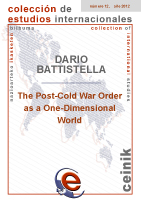The post cold-war order as a one-dimensional world
##plugins.themes.bootstrap3.article.main##
##plugins.themes.bootstrap3.article.sidebar##
Publicado
28-01-2015
Dario Battistella
Resumen
In this paper, the author puts forward a neo-classical realist analysis of the contemporary world order as a one-dimensional world. The main argument consists in claiming that some twenty years after the end of the Cold War, the material structure of the international system, considered to be the independent variable, is characterized by unipolarity, while the normative nature of the international society, considered to be the intermediate variable, is uniform.
This double hierarchy, in favor of the US and its allies, concerning both its economic and military power resources and the values underpinning norms of appropriate behavior, explains the most characteristic features of the post-Cold War world order considered to be the dependent variable: on the one hand the prevalence of neoliberal norms reflects the material superiority of Western powers, on the other hand the supremacy of the US is legitimized and reproduced by the neo-liberal norms regulating the institutionalized international political game. Stable in the short term, this order is likely to evolve in the long run, due to the rise of China as America's future contender and of East Asia as the core of the world order to come.
Dario Battistella is professor of political science at the Institut d'Études Politiques de Bordeaux in France. He is the author of the handbook Théories des relations internationales, 4th ed., Paris, Sciences Po les Presses, 2012, and co-author of Dictionnaire des relations internationales, 3rd ed., Paris, Dalloz, 2012, Other recent books include "The Return of the State of War: A Theoretical Analysis of Operation Iraqi Freedom", Colchester, ECPR Press, 2008, and "Paix et guerres au 21e siècle", Auxerre, Éd. Sciences Humaines, 2011.
This double hierarchy, in favor of the US and its allies, concerning both its economic and military power resources and the values underpinning norms of appropriate behavior, explains the most characteristic features of the post-Cold War world order considered to be the dependent variable: on the one hand the prevalence of neoliberal norms reflects the material superiority of Western powers, on the other hand the supremacy of the US is legitimized and reproduced by the neo-liberal norms regulating the institutionalized international political game. Stable in the short term, this order is likely to evolve in the long run, due to the rise of China as America's future contender and of East Asia as the core of the world order to come.
Dario Battistella is professor of political science at the Institut d'Études Politiques de Bordeaux in France. He is the author of the handbook Théories des relations internationales, 4th ed., Paris, Sciences Po les Presses, 2012, and co-author of Dictionnaire des relations internationales, 3rd ed., Paris, Dalloz, 2012, Other recent books include "The Return of the State of War: A Theoretical Analysis of Operation Iraqi Freedom", Colchester, ECPR Press, 2008, and "Paix et guerres au 21e siècle", Auxerre, Éd. Sciences Humaines, 2011.
##plugins.themes.bootstrap3.article.details##
Sección
Texto completo

